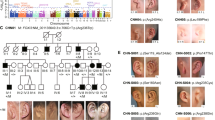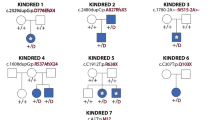Abstract
Char syndrome is an autosomal dominant trait characterized by patent ductus arteriosus, facial dysmorphism and hand anomalies. Using a positional candidacy strategy, we mapped TFAP2B, encoding a transcription factor expressed in neural crest cells, to the Char syndrome critical region and identified missense mutations altering conserved residues in two affected families. Mutant TFAP2B proteins dimerized properly in vitro, but showed abnormal binding to TFAP2 target sequence. Dimerization of both mutants with normal TFAP2B adversely affected transactivation, demonstrating a dominant-negative mechanism. Our work shows that TFAP2B has a role in ductal, facial and limb development and suggests that Char syndrome results from derangement of neural-crest-cell derivatives.
This is a preview of subscription content, access via your institution
Access options
Subscribe to this journal
Receive 12 print issues and online access
$209.00 per year
only $17.42 per issue
Buy this article
- Purchase on Springer Link
- Instant access to full article PDF
Prices may be subject to local taxes which are calculated during checkout






Similar content being viewed by others
References
Mullins, C.E. & Pagotto, L. Patent ductus arteriosus. in The Science and Practice of Pediatric Cardiology (eds Garson, A.J., Bricker, J.T., Fisher, D.J. & Neish, S.R.) 1181– 1197 (Williams and Wilkins, Baltimore, 1998).
Nora, J.J. & Nora, A.H. Update on counseling the family with a first degree relative with a congenital heart defects. Am. J. Med. Genet. 29, 137–142 (1988).
Zetterqvist, P.A. Clinical and Genetic Study of Congenital Heart Defects. Thesis, Univ. Uppsala (1972).
Char, F. Peculiar facies with short philtrum, duck-bill lips, ptosis, and low-set ears—a new syndrome? Birth Defects Orig. Arctic Ser. 14, 303–305 (1978).
Satoda, M., Pierpont, M.E.M., Diaz, G.A. & Gelb, B.D. Char syndrome, an inherited disorder with patent ductus arteriosus, maps to chromosome 6p12–p21. Circulation 99, 3036–3042 (1999).
Moser, M. et al. Cloning and characterization of a second AP-2 transcription factor: AP-2β. Development 121, 2779– 2788 (1995).
Davidson, H.R. A large family with patent ductus arteriosus and unusual face. J. Med. Genet. 30, 503–505 (1993).
Williams, T. & Tjian, R. Characterization of a dimerization motif in AP-2 and its function in heterologous DNA-binding proteins. Science 251, 1067–1071 ( 1991).
Williams, T. & Tjian, R. Analysis of the DNA-binding and activation properties of the human transcriptional factor AP-2. Genes Dev . 5, 670–682 ( 1991).
Kannan, P. & Tainsky, M.A. Coactivator PC4 mediates AP-2 transcriptional activity and suppresses ras-induced transformation dependent on AP-2 transcriptional interference. Mol. Cell. Biol. 19, 899–908 (1999).
Kannan, P., Yu, Y., Wankhade, S. & Tainsky, M.A. PolyADP-ribose polymerase is a coactivator for AP-2-mediated transcriptional activation. Nucleic Acids Res. 27, 866–874 (1999).
Lüscher, B., Mitchell, P.J., Williams, T. & Tjian, R. Regulation of transcription factor AP-2 by the morphogen retinoic acid and by second messengers. Genes Dev. 3, 1507 –1517 (1989).
Mitchell, P.J., Timmons, P.M., Hébert, J.M., Rigby, P.W.J. & Tjian, R. Transcriptional factor AP-2 is expressed in neural crest cell lineages during mouse embryogenesis. Genes Dev. 5, 105–119 ( 1991).
Philipp, J., Mitchell, P.J., Malipiero, U. & Fontana, A. Cell type-specific regulation of expression of transcription factor AP-2 in neuroectodermal cells. Dev. Biol. 165, 602 –614 (1994).
Moser, M., Rüschoff, J. & Buettner, R. Comparative analysis of AP-2α and AP-2β gene expression during mouse embryogenesis. Dev. Dyn. 208 , 115–124 (1997).
Moser, M. et al. Enhanced apoptotic cell death of renal epithelial cell in mice lacking transcriptional factor AP-2β. Genes Dev. 11, 1938–1948 (1997).
Kirby, M.L., Gale, T.F. & Stewart, D.E. Neural crest cells contribute to normal aorticopulmonary septation. Science 220, 1059– 1061 (1983).
Waldo, K.L. & Kirby, M.L. Cardiac neural crest contribution to the pulmonary artery and sixth aortic arch artery complex in chick embryos aged 6 to 18 days. Anat. Rec. 237, 385– 399 (1993).
Conway, S.J., Henderson, D.J. & Copp, A.J. Pax3 is required for cardiac neural crest migration in the mouse: evidence from the splotch (Sp2H) mutant . Development 124, 505– 514 (1997).
Fukiishi, Y. & Morriss-Kay, G.M. Migration of cranial neural crest cells to the pharyngeal arches and heart in rat embryos. Cell Tiss. Res. 268, 1–8 (1992).
Nishibatake, M., Kirby, M.L. & van Mierop, L.H. Pathogenesis of persistent truncus arteriosus and dextraposed aorta in the chick embryo after neural crest ablation. Circulation 75, 255–264 (1987).
Yanagisawa, H. et al. Role of endothelin-1/endothelin-a receptor-mediated signaling pathway in the aortic arch patterning in mice. J. Clin. Invest . 102, 22–33 ( 1998).
Franz, T. Persistent truncus arteriosus in the Splotch mutant mouse. Anat. Embryol. 180, 457–474 ( 1989).
Epstein, D.J., Vekemans, M. & Gros, P. splotch (Sp2h), a mutation affecting development of the mouse neural tube, shows a deletion within the paired homeodomain of Pax-3 . Cell 67, 767–774 (1991).
Reaume, A.G. et al. Cardiac malformation in neonatal mice lacking connexin43. Science 267, 1831–1834 ( 1995).
Ewart, J.L. et al. Heart and neural tube defects in transgenic mice overexpressing the Cx43 gap junction gene. Development 124, 1281–1292 (1997).
Sullivan, R. et al. Heart malformations in transgenic mice exhibiting dominant negative inhibition of gap junctional communication in neural crest cells . Dev. Biol. 204, 224–234 (1998).
Waldo, K.L., Lo, C.W. & Kirby, M.L. Connexin 43 expression reflects neural crest patterns during cardiovascular development. Dev. Biol. 208, 307–323 (1999).
Wilson, G.N. Correlated heart/limb anomalies in Mendelian syndromes provide evidence for a cardiomelic developmental field. Am. J. Med. Genet. 76, 297–305 (1998).
Basson, C.T. et al. Mutations in human cause limb and cardiac malformation in Holt-Oram syndrome. Nature Genet. 15, 30 –35 (1997).
Li, Q.Y. et al. Holt-Oram syndrome is caused by mutations in TBX5, a member of the Brachyury (T) gene family. Nature Genet. 15, 21–29 (1997).
Bamshad, M. et al. Mutations in human TBX3 alter limb, apocrine and genital development in ulnar-mammary syndrome. Nature Genet. 16, 311–315 (1997).
Lens, X.M. et al. An integrated genetic and physical map of the autosomal recessive polycystic kidney disease region. Genomics 41, 463–466 (1997).
Acknowledgements
We thank the two Char family members for their participation and J. Licht for critical reading of this manuscript. This study was supported in part by NIH grants to B.D.G. (HD01294 and HD38018).
Author information
Authors and Affiliations
Corresponding author
Rights and permissions
About this article
Cite this article
Satoda, M., Zhao, F., Diaz, G. et al. Mutations in TFAP2B cause Char syndrome, a familial form of patent ductus arteriosus. Nat Genet 25, 42–46 (2000). https://doi.org/10.1038/75578
Received:
Accepted:
Issue Date:
DOI: https://doi.org/10.1038/75578
This article is cited by
-
Angular limb deformity associated with TSPAN18, NRG3 and NOVA2 in Rambouillet rams
Scientific Reports (2023)
-
Tfap2b acts in GABAergic neurons to control sleep in mice
Scientific Reports (2023)
-
Co-expression of transcription factor AP-2beta (TFAP2B) and GATA3 in human mammary epithelial cells with intense, apicobasal immunoreactivity for CK8/18
Journal of Molecular Histology (2021)
-
CHD7 promotes neural progenitor differentiation in embryonic stem cells via altered chromatin accessibility and nascent gene expression
Scientific Reports (2020)
-
Comprehensive analysis of the expression and prognosis for TFAP2 in human lung carcinoma
Genes & Genomics (2020)



